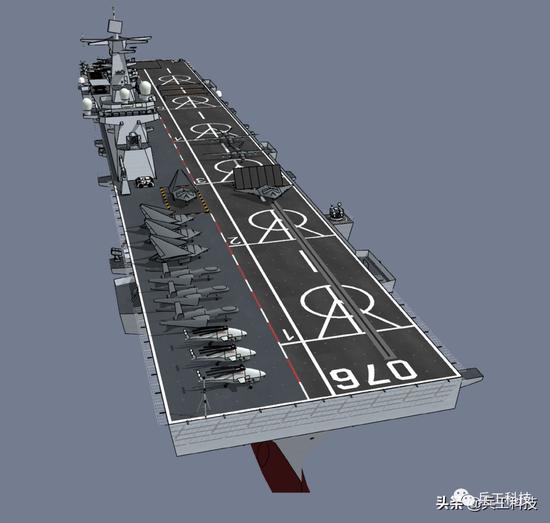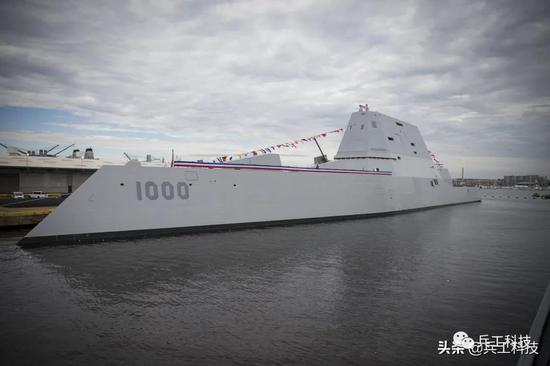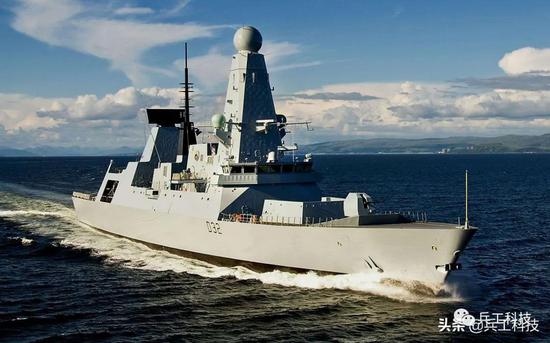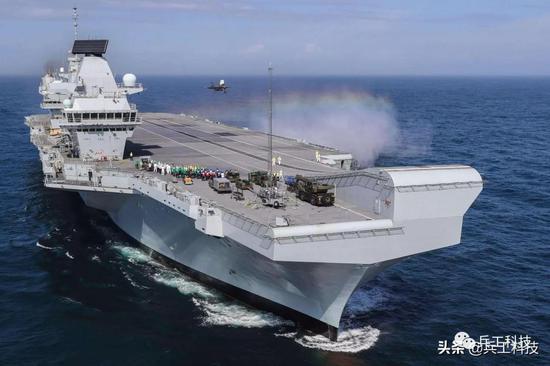https://mil.news.sina.com.cn/zhengming/2020-09-12/doc-iivhvpwy6299895.shtml
燃气轮机+综合电力:076舰的动力系统为何会如此选择
2020年09月12日 11:51 军事自媒体 作者:兵工科技
0
来源:兵工科技
近期,关于我国新一代076型两栖攻击舰的消息甚嚣尘上。从中国船舶工业集团708所公开的招标信息和技术项目来看,新一代076型两栖攻击舰将采用多种新技术,其中最引人瞩目当属“DCTS槽道火灾控制技术试验研究”,“DCTS”应该是“电磁弹射”的拼音缩写,这意味着076型两栖攻击舰未来很有可能采用电磁弹射技术。此外,招标内容中还提到了21MW级燃气轮机、6MW级柴油机以及“J用中压直流”等研制项目,这表明076型两栖攻击舰的动力系统应该是以21兆瓦燃气轮机和6兆瓦柴油机为核心的全电推进系统。事实上,电磁弹射技术需要耗费巨大的电能,燃气轮机加综合电力系统的配置,刚好可以满足电磁弹射系统的耗能需求,这也是我国未来舰艇发展一个主要方向。

076型两栖攻击舰的动力系统应该是以21兆瓦燃气轮机和6兆瓦柴油机为核心的全电推进系统
为什么是舰船综合电力系统?
所谓舰船综合电力系统,是指将传统舰船中相互独立的动力和电力两大系统合二为一,以电能的形式统一为推进负载、脉冲负载、通信、导航和日用设备等供电,实现了全舰能源的综合利用。相比于传统动力系统,舰船综合电力系统具有以下显著的优势。
首先,综合电力系统有利于舰船总体优化设计,使动力系统的布置更具有灵活性,提高舰船机动性、操控性、续航力和使用的经济性。由于突破了将发动机、推进器、传动轴系布置在一条直线上的传统机械推进模式,用电缆完全取代机械连接,使全舰系统和设备布置更加灵活。采用舰船综合电力系统,可以缩短轴系,减少热机的数量及特种发电设备,节约了空间,简化了舰船动力平台的结构,其系统化、模块化和集成化的设计思想有利于舰船总体优化设计。
此外,电力推进可通过转换电源的极性或相位,快捷实现反向运转,从而提高舰船的操控性。舰船综合电力系统还可根据用电负荷容量调节原动机数量,提高原动机负荷率,降低油耗和维护费用,提高续航力。据美国海军海洋系统先进水面舰船机械研究小组计算,一艘采用综合电力系统的舰船与同等吨位的机械推进舰船相比,年节省燃油超过20%。
其次,综合电力系统与机械推进系统相比,由于取消了传动轴和齿轮箱,原动机与推进电机不存在机械连接,缩短了轴系,隔断了机械振动噪声的主要传递途径,而且原动机可以布置在水线以上,从而可以大大降低水下辐射噪声,使得自身更加安静。与机械推进相比,在宽频带可降低噪声15-20分贝,在窄频带降低更多。因此,提高了对水下目标(如潜艇)的综合探测和作战能力,增强舰船的声隐身性能。

综合电力推进系统是未来舰艇动力系统发展的一大趋势
最后,综合电力舰艇降低了机械振动和冲击,其舰体结构不易疲劳,有助于提高舰艇的使用寿命。采取集中供电的方式,且从发电机组到推进电机等各个环节都有一定的冗余,其中任何一部原动机、发电机组和推进电机故障都不会影响推进器的工作。通过合理布局和控制分配等保护保护手段,使系统具有很强的抗故障能力,提高了舰船的生命力。由于大量减少了机械推进装置所必须油、液、气等复杂的密闭管路系统和辅助设备,取而代之的是体积小、重量轻、可靠性高的电机、电子和电气元件、集成线路和各种电线电缆,总体系统复杂性大为降低。因此,其大修、改造和组件更换也比机械传动装置要容易,使用和作战中的可保障性、便捷性大大提高。
此外,舰船综合电力系统的出现,还为电磁炮、电热化学炮、激光武器、微波等新概念高能武器的上舰,奠定了基础。
为什么是燃气轮机,而非蒸汽轮机?
从目前世界范围内来看,综合电力系统已经成为舰船发展的必然潮流与趋势,而燃气轮机加综合电力系统的配置则是大型舰船以及航母的最优选择。076两栖攻击舰将采用电磁弹射技术,且吨位相比于075应该只大不小,普通的柴油动力功率太小,无法满足电磁弹射消耗及其动力所需,以075两栖攻击舰为例,其使用四台大型柴油机,总功率48兆瓦,要负担电磁弹射几乎是不可能的;相比之下,以蒸汽轮机、燃气轮机等为主要动力的全电推进系统,才能满足076两栖攻击舰的需求。
最显著的例子就是采用综合电力系统的英国伊丽莎白女王级航母,其主动力系统为2台36MW的MT-30燃气轮机、巡航动力为2台单机功率9MW的瓦锡兰12V38B柴油发电机组。主动力系统最大输出功率108MW,其中80MW用于驱动4台单机功率20MW的法国科孚德机电公司的先进感应电机,总推进功率10.8万马力,可以使6.5万吨的航母达到26节的最高航速。燃气轮机加综合电力系统的组合,即使像航母这样的超大型军舰也能达到满意的动力性能,更何况是吨位相对较小的两栖攻击舰了。所以,中国076两栖攻击舰如果同时配置四台21兆瓦燃气轮机的话,其动力水平将会超过“伊丽莎白女王级”航母,足够支撑起电磁弹射系统和全舰其他系统的电力消耗。

采用综合电力推进系统,有助于舰船的优化设计,大幅提高乐舰船的机动性、操控性、续航力和使用的经济性
至于为何采用燃气轮机而不是采用蒸汽轮机,则是因为燃气轮机具有蒸汽轮机无法比拟的启动性和加速性。比如一艘蒸汽轮机航母如果要出港,必须先检查锅炉,生火燃烧起码需要十几个小时,而燃气轮机航母8小时就能搞定;在加速方面,燃气轮机也是完爆蒸汽轮机,比如蒸汽动力航母从巡航时速加速到30节左右的最高航速,需要2小时,而燃气动力航母只需20分钟,如此巨大的差距,在实战中是致命的。而相比蒸汽轮机,燃气轮机唯一的缺点可能就是巨大的耗油量。不过随着技术进步,如今的高性能燃气轮机已经可以做到更低的油耗,伊丽莎白女王级的MT-30燃气轮机全功率油耗为207克/千瓦·时,已经和中高速柴油机210克/千瓦/时的全功率油耗相当。
除此之外,燃气轮机另一大优点是可靠性和维护性好,舰用燃气轮机一般由成熟的航空发动机演变而来,经典的LM-2500由C5运输机上的TF-39涡扇发动机发展而来,至今已销售超过2000台,总运行时数已经超过惊人的5千万小时。伊丽莎白女王级的MT-30燃气轮机由特伦特800航空发动机派生而来,该发动机用于波音757和波音777,装机总数达250台,累积使用500多万小时,可靠性高达99.9%。

英国伊丽莎白女王级航母采用了燃气轮机加综合电力系统的组合方式,中国076两栖攻击舰也将采用这种动力系统
结语
综上所述,076燃气轮机加综合电力系统的组合,符合未来舰艇动力系统的发展方向,也是世界各国舰艇发展的一大趋势。当然了,从长远方向来看,核动力加全电动力无疑是大型舰艇动力系统的最优选择,但舰用核反应堆研制周期长、成本高、技术难度大,对于目前中国海军来说,燃气轮机加综合电力方案比较适合未来发展需求。
Gas Turbine + Integrated Electricity: Why is the power system of the 076 ship so selected
2020 at 11:51 on September 12 of the military from the media: Ordnance Technology
0
Source: Ordnance Technology
Recently, news about our country’s new generation of Type 076 amphibious assault ship has been rampant. Judging from the bidding information and technical projects disclosed by China State Shipbuilding Corporation 708, the new generation of Type 076 amphibious assault ship will adopt a variety of new technologies, of which the most eye-catching is "DCTS channel fire control technology experimental research". "DCTS" should be the pinyin abbreviation of "electromagnetic ejection", which means that the Type 076 amphibious assault ship is likely to adopt electromagnetic ejection technology in the future. In addition, the tender content also mentioned 21MW-class gas turbines, 6MW-class diesel engines and "J-use medium-voltage direct current" development projects, which indicates that the power system of the 076 amphibious assault ship should be based on 21 MW gas turbines and 6 MW diesel engines. The core all-electric propulsion system. In fact, electromagnetic ejection technology needs to consume huge amounts of electricity. The configuration of gas turbine and integrated power system can just meet the energy demand of electromagnetic ejection system. This is also a main direction for the future development of ships in my country.
The power system of the 076 amphibious assault ship should be an all-electric propulsion system with 21 MW gas turbine and 6 MW diesel engine as the core.
Why is the ship integrated power system?
The so-called integrated ship power system refers to the integration of the two independent power and electric power systems of traditional ships into one, and unified power supply for propulsion loads, pulse loads, communications, navigation, and daily equipment in the form of electrical energy. It has realized the comprehensive utilization of the whole ship's energy. Compared with the traditional power system, the ship integrated power system has the following significant advantages.
First of all, the integrated power system is conducive to the overall optimization design of the ship, making the layout of the power system more flexible, and improving the maneuverability, maneuverability, endurance and economic efficiency of the ship. As a result of breaking through the traditional mechanical propulsion mode of arranging the engine, propeller, and transmission shaft system in a straight line, the mechanical connection is completely replaced by cables, which makes the layout of the whole ship system and equipment more flexible. The use of the ship’s integrated power system can shorten the shafting, reduce the number of heat engines and special power generation equipment, save space, and simplify the structure of the ship’s power platform. Its systematic, modular and integrated design ideas are beneficial to ships. Overall optimization design.
In addition, electric propulsion can quickly realize reverse operation by changing the polarity or phase of the power source, thereby improving the maneuverability of the ship. The ship's integrated power system can also adjust the number of prime movers according to the power load capacity, increase prime mover load rate, reduce fuel consumption and maintenance costs, and increase endurance. According to calculations by the U.S. Navy Marine System Advanced Surface Ship Machinery Research Group, a ship using an integrated power system can save more than 20% of fuel annually compared to a mechanically propelled ship of the same tonnage.
Secondly, compared with the mechanical propulsion system, the integrated electric system has eliminated the transmission shaft and gearbox, the prime mover and the propulsion motor do not have a mechanical connection, which shortens the shaft system and cuts off the main transmission path of mechanical vibration and noise. Arranged above the waterline, which can greatly reduce underwater radiation noise and make itself more quiet. Compared with mechanical propulsion, the noise can be reduced by 15-20 decibels in a wide frequency band and more in a narrow frequency band. Therefore, the comprehensive detection and combat capabilities of underwater targets (such as submarines) are improved, and the acoustic stealth performance of ships is enhanced.
Integrated electric propulsion system is a major trend in the development of naval power systems in the future
Finally, the integrated electric ship reduces mechanical vibration and shock, and its hull structure is not easy to fatigue, which helps to increase the service life of the ship. A centralized power supply is adopted, and all links from the generator set to the propulsion motor have a certain degree of redundancy. Any failure of the prime mover, generator set and propulsion motor will not affect the operation of the propeller. By means of protection and protection such as reasonable layout and control distribution, the system has strong anti-failure ability and improves the vitality of ships. As the oil, liquid, gas and other complicated closed piping systems and auxiliary equipment necessary for the mechanical propulsion device are greatly reduced, it is replaced by small, light, and highly reliable motors, electronic and electrical components, integrated circuits and various Wire and cable, the overall system complexity is greatly reduced. Therefore, its overhaul, transformation and component replacement are also easier than mechanical transmission devices, and the security and convenience in use and combat are greatly improved.
In addition, the emergence of the ship's integrated power system also laid the foundation for the launch of new high-energy weapons such as electromagnetic guns, electrothermal chemical guns, laser weapons, and microwaves.
Why is a gas turbine instead of a steam turbine?
From the current worldwide perspective, the integrated power system has become the inevitable trend and trend of ship development, and the configuration of gas turbine plus integrated power system is the best choice for large ships and aircraft carriers. The 076 amphibious assault ship will use electromagnetic ejection technology, and the tonnage should be no smaller than that of the 075. The ordinary diesel power is too small to meet the electromagnetic ejection consumption and power requirements. Take the 075 amphibious assault ship as an example. With four large diesel engines with a total power of 48 MW, it is almost impossible to bear electromagnetic ejection; in contrast, the all-electric propulsion system with steam turbines and gas turbines as the main power can meet the needs of the 076 amphibious assault ship .
The most significant example is the British Queen Elizabeth-class aircraft carrier that uses an integrated power system. Its main power system is two 36MW MT-30 gas turbines, and the cruise power is two Wärtsilä 12V38B diesel generator sets with a single power of 9MW. The maximum output power of the main power system is 108MW, of which 80MW is used to drive 4 advanced induction motors of French Corfude Electromechanical Company with a single power of 20MW. The total propulsion power is 108,000 horsepower, which can make the 65,000-ton aircraft carrier reach a maximum speed of 26 knots . With the combination of gas turbine and integrated power system, even a super-large warship like an aircraft carrier can achieve satisfactory power performance, let alone an amphibious assault ship with a relatively small tonnage. Therefore, if the China 076 amphibious assault ship is equipped with four 21 MW gas turbines at the same time, its power level will exceed the "Queen Elizabeth class" aircraft carrier, which is enough to support the power consumption of the electromagnetic ejection system and other systems of the ship.
Using an integrated electric propulsion system helps to optimize the design of the ship, and greatly improves the maneuverability, maneuverability, endurance and economic efficiency of the ship
As for why gas turbines are used instead of steam turbines, it is because gas turbines have start-up and acceleration that steam turbines can’t match. For example, if a steam turbine aircraft carrier wants to leave the port, the boiler must be inspected. It takes at least ten hours to start a fire, while a gas turbine aircraft carrier can be completed in 8 hours. In terms of acceleration, the gas turbine is also a steam turbine, such as a steam-powered aircraft carrier. It takes 2 hours to accelerate to the top speed of about 30 knots, while the gas-powered aircraft carrier only takes 20 minutes. Such a huge gap is fatal in actual combat. Compared with steam turbines, the only disadvantage of gas turbines may be their huge fuel consumption. However, with technological progress, today's high-performance gas turbines can achieve lower fuel consumption. The full-power fuel consumption of the Queen Elizabeth-class MT-30 gas turbine is 207g/kW·h, which has been compared with the medium and high-speed diesel engine 210g/kW/h. The fuel consumption of full power is comparable.
In addition, another major advantage of gas turbines is their reliability and maintainability. Naval gas turbines generally evolved from mature aero engines. The classic LM-2500 was developed from the TF-39 turbofan engine on the C5 transport aircraft. , Has sold more than 2,000 units so far, and the total operating hours has exceeded an astonishing 50 million hours. The Queen Elizabeth-class MT-30 gas turbine is derived from the Trent 800 aircraft engine. The engine is used in the Boeing 757 and Boeing 777. The total installed capacity is 250 units, the cumulative use is more than 5 million hours, and the reliability is as high as 99.9%.
The British Queen Elizabeth-class aircraft carrier uses a combination of gas turbines and integrated power systems, and the Chinese 076 amphibious assault ship will also use this power system
Conclusion
To sum up, the combination of 076 gas turbine and integrated power system is in line with the future development direction of naval power systems, and it is also a major trend in the development of naval ships in the world. Of course, from a long-term perspective, nuclear power plus full electric power is undoubtedly the best choice for large-scale naval power systems, but ship nuclear reactors have long development periods, high costs, and technical difficulties. For the Chinese Navy, gas turbines plus The comprehensive power plan is more suitable for future development needs.
燃气轮机+综合电力:076舰的动力系统为何会如此选择
2020年09月12日 11:51 军事自媒体 作者:兵工科技
0
来源:兵工科技
近期,关于我国新一代076型两栖攻击舰的消息甚嚣尘上。从中国船舶工业集团708所公开的招标信息和技术项目来看,新一代076型两栖攻击舰将采用多种新技术,其中最引人瞩目当属“DCTS槽道火灾控制技术试验研究”,“DCTS”应该是“电磁弹射”的拼音缩写,这意味着076型两栖攻击舰未来很有可能采用电磁弹射技术。此外,招标内容中还提到了21MW级燃气轮机、6MW级柴油机以及“J用中压直流”等研制项目,这表明076型两栖攻击舰的动力系统应该是以21兆瓦燃气轮机和6兆瓦柴油机为核心的全电推进系统。事实上,电磁弹射技术需要耗费巨大的电能,燃气轮机加综合电力系统的配置,刚好可以满足电磁弹射系统的耗能需求,这也是我国未来舰艇发展一个主要方向。

076型两栖攻击舰的动力系统应该是以21兆瓦燃气轮机和6兆瓦柴油机为核心的全电推进系统
为什么是舰船综合电力系统?
所谓舰船综合电力系统,是指将传统舰船中相互独立的动力和电力两大系统合二为一,以电能的形式统一为推进负载、脉冲负载、通信、导航和日用设备等供电,实现了全舰能源的综合利用。相比于传统动力系统,舰船综合电力系统具有以下显著的优势。
首先,综合电力系统有利于舰船总体优化设计,使动力系统的布置更具有灵活性,提高舰船机动性、操控性、续航力和使用的经济性。由于突破了将发动机、推进器、传动轴系布置在一条直线上的传统机械推进模式,用电缆完全取代机械连接,使全舰系统和设备布置更加灵活。采用舰船综合电力系统,可以缩短轴系,减少热机的数量及特种发电设备,节约了空间,简化了舰船动力平台的结构,其系统化、模块化和集成化的设计思想有利于舰船总体优化设计。
此外,电力推进可通过转换电源的极性或相位,快捷实现反向运转,从而提高舰船的操控性。舰船综合电力系统还可根据用电负荷容量调节原动机数量,提高原动机负荷率,降低油耗和维护费用,提高续航力。据美国海军海洋系统先进水面舰船机械研究小组计算,一艘采用综合电力系统的舰船与同等吨位的机械推进舰船相比,年节省燃油超过20%。
其次,综合电力系统与机械推进系统相比,由于取消了传动轴和齿轮箱,原动机与推进电机不存在机械连接,缩短了轴系,隔断了机械振动噪声的主要传递途径,而且原动机可以布置在水线以上,从而可以大大降低水下辐射噪声,使得自身更加安静。与机械推进相比,在宽频带可降低噪声15-20分贝,在窄频带降低更多。因此,提高了对水下目标(如潜艇)的综合探测和作战能力,增强舰船的声隐身性能。

综合电力推进系统是未来舰艇动力系统发展的一大趋势
最后,综合电力舰艇降低了机械振动和冲击,其舰体结构不易疲劳,有助于提高舰艇的使用寿命。采取集中供电的方式,且从发电机组到推进电机等各个环节都有一定的冗余,其中任何一部原动机、发电机组和推进电机故障都不会影响推进器的工作。通过合理布局和控制分配等保护保护手段,使系统具有很强的抗故障能力,提高了舰船的生命力。由于大量减少了机械推进装置所必须油、液、气等复杂的密闭管路系统和辅助设备,取而代之的是体积小、重量轻、可靠性高的电机、电子和电气元件、集成线路和各种电线电缆,总体系统复杂性大为降低。因此,其大修、改造和组件更换也比机械传动装置要容易,使用和作战中的可保障性、便捷性大大提高。
此外,舰船综合电力系统的出现,还为电磁炮、电热化学炮、激光武器、微波等新概念高能武器的上舰,奠定了基础。
为什么是燃气轮机,而非蒸汽轮机?
从目前世界范围内来看,综合电力系统已经成为舰船发展的必然潮流与趋势,而燃气轮机加综合电力系统的配置则是大型舰船以及航母的最优选择。076两栖攻击舰将采用电磁弹射技术,且吨位相比于075应该只大不小,普通的柴油动力功率太小,无法满足电磁弹射消耗及其动力所需,以075两栖攻击舰为例,其使用四台大型柴油机,总功率48兆瓦,要负担电磁弹射几乎是不可能的;相比之下,以蒸汽轮机、燃气轮机等为主要动力的全电推进系统,才能满足076两栖攻击舰的需求。
最显著的例子就是采用综合电力系统的英国伊丽莎白女王级航母,其主动力系统为2台36MW的MT-30燃气轮机、巡航动力为2台单机功率9MW的瓦锡兰12V38B柴油发电机组。主动力系统最大输出功率108MW,其中80MW用于驱动4台单机功率20MW的法国科孚德机电公司的先进感应电机,总推进功率10.8万马力,可以使6.5万吨的航母达到26节的最高航速。燃气轮机加综合电力系统的组合,即使像航母这样的超大型军舰也能达到满意的动力性能,更何况是吨位相对较小的两栖攻击舰了。所以,中国076两栖攻击舰如果同时配置四台21兆瓦燃气轮机的话,其动力水平将会超过“伊丽莎白女王级”航母,足够支撑起电磁弹射系统和全舰其他系统的电力消耗。

采用综合电力推进系统,有助于舰船的优化设计,大幅提高乐舰船的机动性、操控性、续航力和使用的经济性
至于为何采用燃气轮机而不是采用蒸汽轮机,则是因为燃气轮机具有蒸汽轮机无法比拟的启动性和加速性。比如一艘蒸汽轮机航母如果要出港,必须先检查锅炉,生火燃烧起码需要十几个小时,而燃气轮机航母8小时就能搞定;在加速方面,燃气轮机也是完爆蒸汽轮机,比如蒸汽动力航母从巡航时速加速到30节左右的最高航速,需要2小时,而燃气动力航母只需20分钟,如此巨大的差距,在实战中是致命的。而相比蒸汽轮机,燃气轮机唯一的缺点可能就是巨大的耗油量。不过随着技术进步,如今的高性能燃气轮机已经可以做到更低的油耗,伊丽莎白女王级的MT-30燃气轮机全功率油耗为207克/千瓦·时,已经和中高速柴油机210克/千瓦/时的全功率油耗相当。
除此之外,燃气轮机另一大优点是可靠性和维护性好,舰用燃气轮机一般由成熟的航空发动机演变而来,经典的LM-2500由C5运输机上的TF-39涡扇发动机发展而来,至今已销售超过2000台,总运行时数已经超过惊人的5千万小时。伊丽莎白女王级的MT-30燃气轮机由特伦特800航空发动机派生而来,该发动机用于波音757和波音777,装机总数达250台,累积使用500多万小时,可靠性高达99.9%。

英国伊丽莎白女王级航母采用了燃气轮机加综合电力系统的组合方式,中国076两栖攻击舰也将采用这种动力系统
结语
综上所述,076燃气轮机加综合电力系统的组合,符合未来舰艇动力系统的发展方向,也是世界各国舰艇发展的一大趋势。当然了,从长远方向来看,核动力加全电动力无疑是大型舰艇动力系统的最优选择,但舰用核反应堆研制周期长、成本高、技术难度大,对于目前中国海军来说,燃气轮机加综合电力方案比较适合未来发展需求。
Gas Turbine + Integrated Electricity: Why is the power system of the 076 ship so selected
2020 at 11:51 on September 12 of the military from the media: Ordnance Technology
0
Source: Ordnance Technology
Recently, news about our country’s new generation of Type 076 amphibious assault ship has been rampant. Judging from the bidding information and technical projects disclosed by China State Shipbuilding Corporation 708, the new generation of Type 076 amphibious assault ship will adopt a variety of new technologies, of which the most eye-catching is "DCTS channel fire control technology experimental research". "DCTS" should be the pinyin abbreviation of "electromagnetic ejection", which means that the Type 076 amphibious assault ship is likely to adopt electromagnetic ejection technology in the future. In addition, the tender content also mentioned 21MW-class gas turbines, 6MW-class diesel engines and "J-use medium-voltage direct current" development projects, which indicates that the power system of the 076 amphibious assault ship should be based on 21 MW gas turbines and 6 MW diesel engines. The core all-electric propulsion system. In fact, electromagnetic ejection technology needs to consume huge amounts of electricity. The configuration of gas turbine and integrated power system can just meet the energy demand of electromagnetic ejection system. This is also a main direction for the future development of ships in my country.
The power system of the 076 amphibious assault ship should be an all-electric propulsion system with 21 MW gas turbine and 6 MW diesel engine as the core.
Why is the ship integrated power system?
The so-called integrated ship power system refers to the integration of the two independent power and electric power systems of traditional ships into one, and unified power supply for propulsion loads, pulse loads, communications, navigation, and daily equipment in the form of electrical energy. It has realized the comprehensive utilization of the whole ship's energy. Compared with the traditional power system, the ship integrated power system has the following significant advantages.
First of all, the integrated power system is conducive to the overall optimization design of the ship, making the layout of the power system more flexible, and improving the maneuverability, maneuverability, endurance and economic efficiency of the ship. As a result of breaking through the traditional mechanical propulsion mode of arranging the engine, propeller, and transmission shaft system in a straight line, the mechanical connection is completely replaced by cables, which makes the layout of the whole ship system and equipment more flexible. The use of the ship’s integrated power system can shorten the shafting, reduce the number of heat engines and special power generation equipment, save space, and simplify the structure of the ship’s power platform. Its systematic, modular and integrated design ideas are beneficial to ships. Overall optimization design.
In addition, electric propulsion can quickly realize reverse operation by changing the polarity or phase of the power source, thereby improving the maneuverability of the ship. The ship's integrated power system can also adjust the number of prime movers according to the power load capacity, increase prime mover load rate, reduce fuel consumption and maintenance costs, and increase endurance. According to calculations by the U.S. Navy Marine System Advanced Surface Ship Machinery Research Group, a ship using an integrated power system can save more than 20% of fuel annually compared to a mechanically propelled ship of the same tonnage.
Secondly, compared with the mechanical propulsion system, the integrated electric system has eliminated the transmission shaft and gearbox, the prime mover and the propulsion motor do not have a mechanical connection, which shortens the shaft system and cuts off the main transmission path of mechanical vibration and noise. Arranged above the waterline, which can greatly reduce underwater radiation noise and make itself more quiet. Compared with mechanical propulsion, the noise can be reduced by 15-20 decibels in a wide frequency band and more in a narrow frequency band. Therefore, the comprehensive detection and combat capabilities of underwater targets (such as submarines) are improved, and the acoustic stealth performance of ships is enhanced.
Integrated electric propulsion system is a major trend in the development of naval power systems in the future
Finally, the integrated electric ship reduces mechanical vibration and shock, and its hull structure is not easy to fatigue, which helps to increase the service life of the ship. A centralized power supply is adopted, and all links from the generator set to the propulsion motor have a certain degree of redundancy. Any failure of the prime mover, generator set and propulsion motor will not affect the operation of the propeller. By means of protection and protection such as reasonable layout and control distribution, the system has strong anti-failure ability and improves the vitality of ships. As the oil, liquid, gas and other complicated closed piping systems and auxiliary equipment necessary for the mechanical propulsion device are greatly reduced, it is replaced by small, light, and highly reliable motors, electronic and electrical components, integrated circuits and various Wire and cable, the overall system complexity is greatly reduced. Therefore, its overhaul, transformation and component replacement are also easier than mechanical transmission devices, and the security and convenience in use and combat are greatly improved.
In addition, the emergence of the ship's integrated power system also laid the foundation for the launch of new high-energy weapons such as electromagnetic guns, electrothermal chemical guns, laser weapons, and microwaves.
Why is a gas turbine instead of a steam turbine?
From the current worldwide perspective, the integrated power system has become the inevitable trend and trend of ship development, and the configuration of gas turbine plus integrated power system is the best choice for large ships and aircraft carriers. The 076 amphibious assault ship will use electromagnetic ejection technology, and the tonnage should be no smaller than that of the 075. The ordinary diesel power is too small to meet the electromagnetic ejection consumption and power requirements. Take the 075 amphibious assault ship as an example. With four large diesel engines with a total power of 48 MW, it is almost impossible to bear electromagnetic ejection; in contrast, the all-electric propulsion system with steam turbines and gas turbines as the main power can meet the needs of the 076 amphibious assault ship .
The most significant example is the British Queen Elizabeth-class aircraft carrier that uses an integrated power system. Its main power system is two 36MW MT-30 gas turbines, and the cruise power is two Wärtsilä 12V38B diesel generator sets with a single power of 9MW. The maximum output power of the main power system is 108MW, of which 80MW is used to drive 4 advanced induction motors of French Corfude Electromechanical Company with a single power of 20MW. The total propulsion power is 108,000 horsepower, which can make the 65,000-ton aircraft carrier reach a maximum speed of 26 knots . With the combination of gas turbine and integrated power system, even a super-large warship like an aircraft carrier can achieve satisfactory power performance, let alone an amphibious assault ship with a relatively small tonnage. Therefore, if the China 076 amphibious assault ship is equipped with four 21 MW gas turbines at the same time, its power level will exceed the "Queen Elizabeth class" aircraft carrier, which is enough to support the power consumption of the electromagnetic ejection system and other systems of the ship.
Using an integrated electric propulsion system helps to optimize the design of the ship, and greatly improves the maneuverability, maneuverability, endurance and economic efficiency of the ship
As for why gas turbines are used instead of steam turbines, it is because gas turbines have start-up and acceleration that steam turbines can’t match. For example, if a steam turbine aircraft carrier wants to leave the port, the boiler must be inspected. It takes at least ten hours to start a fire, while a gas turbine aircraft carrier can be completed in 8 hours. In terms of acceleration, the gas turbine is also a steam turbine, such as a steam-powered aircraft carrier. It takes 2 hours to accelerate to the top speed of about 30 knots, while the gas-powered aircraft carrier only takes 20 minutes. Such a huge gap is fatal in actual combat. Compared with steam turbines, the only disadvantage of gas turbines may be their huge fuel consumption. However, with technological progress, today's high-performance gas turbines can achieve lower fuel consumption. The full-power fuel consumption of the Queen Elizabeth-class MT-30 gas turbine is 207g/kW·h, which has been compared with the medium and high-speed diesel engine 210g/kW/h. The fuel consumption of full power is comparable.
In addition, another major advantage of gas turbines is their reliability and maintainability. Naval gas turbines generally evolved from mature aero engines. The classic LM-2500 was developed from the TF-39 turbofan engine on the C5 transport aircraft. , Has sold more than 2,000 units so far, and the total operating hours has exceeded an astonishing 50 million hours. The Queen Elizabeth-class MT-30 gas turbine is derived from the Trent 800 aircraft engine. The engine is used in the Boeing 757 and Boeing 777. The total installed capacity is 250 units, the cumulative use is more than 5 million hours, and the reliability is as high as 99.9%.
The British Queen Elizabeth-class aircraft carrier uses a combination of gas turbines and integrated power systems, and the Chinese 076 amphibious assault ship will also use this power system
Conclusion
To sum up, the combination of 076 gas turbine and integrated power system is in line with the future development direction of naval power systems, and it is also a major trend in the development of naval ships in the world. Of course, from a long-term perspective, nuclear power plus full electric power is undoubtedly the best choice for large-scale naval power systems, but ship nuclear reactors have long development periods, high costs, and technical difficulties. For the Chinese Navy, gas turbines plus The comprehensive power plan is more suitable for future development needs.
